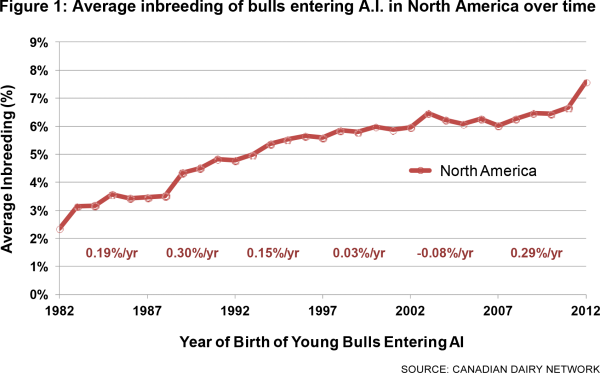Should breeders be concerned about the increasing rate of inbreeding in today’s dairy cattle? Articles are regularly published about the need to lower the rates of inbreeding by such means as cross-breeding. However for purebred breeders planning to remain competitive in advancing their herds genetically, to increase the inventory value of their herds and to maximize the profit from their dairy operations, the matter of increased rates of inbreeding is more than a single item issue.
Breeder Attention to Inbreeding is Limited.
As I follow breeders’ comments on The Milk House (link) and other Facebook posts, I see little breeder concern or perhaps even awareness of any negative impact from focusing on a limited number of bloodlines that are more inbred than the general population.
Showmen often identify Atwood, a Goldwyn son, as the next great sire to follow Goldwyn as the Holstein breed champion in the show ring. Already, before they even receive their first official daughter proofs in December, I hear breeders talking about the attributes, including breed leading TPIs or LPIs of the many daughters they already have in their herds from two unproven bulls, Mogal and Uno. Supersire may not receive an official proof in December but, in time, all three of these sires will enter into the club of very, very extensively used sires that will lead to a further narrowing of the global diversity of Holsteins. That is what happened with Elevation, Astronaut, Blackstar, Shottle, Goldwyn, Planet and Oman in the past.
The Question is ……
Dairy breeders need to be asking themselves “How do I balance genetic improvement, dairy enterprise profit and increasing rates of inbreeding as I mate my herd?”
What is Inbreeding?
In simplest terms, inbreeding is the mating of related animals. The more closely a bull and cow are related, the higher the frequency that their common genes will be passed on to their resulting progeny. Animals that do not meet the breeding goals of breeders do not get the opportunity to have their genes passed on. As a result, the genetic diversity of the population decreases. In short, focused selection contributes significantly to decreased diversity. It is a double-edged sword.
Varying Degrees of Inbreeding.
The Dairy Cattle Reproduction Council (a proactive organization of professionals interested in enhancing reproduction through technology) has produced the following helpful chart to demonstrate the varying degrees of inbreeding.
Some interesting facts can be extrapolated from this chart. Line breeding has been used by dairy cattle breeders to fix the good genes in their herds. But it can also accentuate any negatives associated with the breeding lines used. Selection within a breed has, by far, been the tool of choice for genetic improvement especially since the introduction of artificial insemination. Its contribution to increasing rates of inbreeding has come through the very extensive use of the top sires. Inbred crosses within species has been promoted by some as a solution to the increasing rates of inbreeding but very often the benefits quoted are for single traits and not for total lifetime profit of the resulting generations.
Level of Inbreeding
For North American Holsteins from 1960 to 2010, the levels of inbreeding have gone from zero to 7% to 8%. Moreover, it is continuing to increase at about 0.3% per year.
Impact of Inbreeding in Dollar Terms
Based on USA studies it is estimated that for each 1% increase in inbreeding there is a loss in lifetime net income of $23.11. That equates to a difference of $96.44 for a 9% inbred cow compared to a 5% inbred cow. Canadian and Irish crossbreeding studies show slight lactation losses for milk, fat, and protein yields, but gains for fertility and health traits when breed crossing is practiced. However, neither study reports a net lifetime profit figure comparing breeding pure to crossing breeds.
The question when making a mating decision comes down to correcting for the loss due to inbreeding between the sires under consideration. A sire with an Inbreeding Coefficient of 8% would need to have a NM$ value of about $70 more than a sire with 5% Inbreeding Coefficient for them to be considered equal.
It is more than looking at the Inbreeding Coefficient (IC)
An animals IC tells the degree to which the animal is inbred. However in breeding it is the degree to which the progeny of a mating is inbred that needs to be considered. That means that a sire will not likely produce calves with similar ICs for every mating in your herd. It all depends on a sire’s varying degrees of relationship with your females.
In the USA and Canada information is provided for every sire on how he will mate with the national population of females as to inbreeding level. In the USA the terms used in Effective Future Inbreeding (EFI) and Genomic Future Inbreeding (GFI), while in Canada the term used is Relationship Percent (%R). In all cases, they are general guides to which sires will produce more or less inbred progeny.
What is the Ideal?
The are no perfect numbers for EFI, GFI or %R. It depends on both the genetic merit and inbreeding percent of the resulting progeny. Generally speaking, EFIs and GFIs over 10.0% and %R over 15% of the progeny should be avoided by using an alternate sire that is less related to the dam.
Sound Advice
Dr. Nate Zwald of Alta Genetics provides two thoughts relative to inbreeding:
- Will the use of genomic sires speed up the rate of inbreeding? – “Yes on a breed level it will, but we are also increasing the rate of genetic gain in an incredible way. So our goal should not be a ‘less inbred’ cow but, instead, the most profitable cow. Over the past 25 years, we have created more inbreeding but also more profit. The same is true now with genomics, except that we should now expect both inbreeding and genetic gain to increase at a rate two to three times what we experienced in the past.”
- Does this mean we can soon expect to get to 10 percent inbreeding level on a breed-wide basis? “Yes says Zwald. Geneticists are working on ways to balance the inbreeding level with genetic gain on a breed-wide basis, as a producer you should only be concerned with inbreeding versus genetic gain in your own herd.”
Ways to Select Bulls to Use in Your Herd
In summary, there are basically three ways to address both genetic gain and increased inbreeding:
- Use Outcross Sires that are low for EFI, GFI or %R. (Read more: 12 Outcross Sires to help Control Inbreeding)
- Use a herd mating program that takes into consideration inbreeding. Most AI studs have such a service.
- Use sires that optimize your breeding program that are not closely related to your herd (i.e. GFI below 10% or %R below 16%) (Read more: What’s the plan?)
The Bullvine Bottom Line
As long as breeders plan to rapidly increase the genetic merit of their herds an increasing rate of inbreeding will be with us. Remember when mating a cow and bull it is the genetic merit and inbreeding percent of the resulting progeny that is the focus and not the parents’ values. One breeding program will not suit every breeder, but basing decisions on profit should be part of every plan.
Not sure what all this hype about genomics is all about?
Want to learn what it is and what it means to your breeding program?



















Leave a Reply
You must be logged in to post a comment.